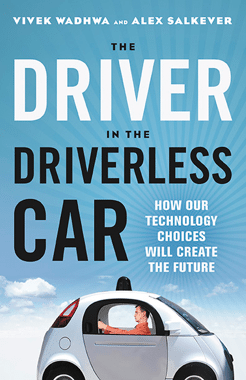Book Review: “The Driver in the Driverless Car by Vivek Wadhwa

This important and timely book explains today’s critical technologies and discusses how the products and markets being spawned will transform our lives in the years to come. It is inspirational, informative, and cautionary, and written for the general reader. Whether you are excited about driverless cars and drones or worried about jobs in the future, this book is for you. The “Notes” section at the end is a good compendium of additional references on the topics discussed.
The good news is that technology developments underway today point to an extraordinary future in which digital technologies continue to transform the world for the better at an accelerated pace. If you’ve read Wadhwa’s columns, you will recognize his style…lively, easy to read, and opinionated. Wadhwa is a futurist who is well-versed in his subject matter, which gives the book an authoritative ring.
Topics covered include advances in education, the revolution in healthcare, the expansion of robotics, cybersecurity issues, drones and their applications, the advances in genetics and their implications, the promise of free energy and clean water, the role of big data and artificial intelligence (AI), and more. This next generation of technology advances will solve many of humanity’s problems, and inevitably create some new ones to be solved by subsequent generations. This is how civilization advances, and the rate of change is accelerating. In a democracy, a knowledgeable citizenry is essential to dealing with the inevitable choices and conundrums along the way. This book shares essential knowledge to enable this.
Wadhwa assesses each technology area by asking three pertinent questions. First: Does the technology have the potential to benefit everyone equally? Second: What are the risks and rewards of this technology development? Third: Does the technology more strongly promote autonomy or dependence? His discussion of tradeoffs and issues is thoughtful and informative.
This book is also a must-read for policymakers and politicians. The timing of its release could not have been better. The Trump administration has shown alarming ignorance about the impact of technology on jobs and industries. As citizens, it is now up to us to take the initiative to make our voices heard, and this book will educate you on talking points that arouse your passion.
Moore’s Law is at the heart of current disruptive technology trends. Wadhwa appropriately devotes a full chapter early in the book to the changes wrought through application of this law. Gordon Moore was co-founder of Intel, and he correctly predicted the continuing exponential decline in cost for digital chips. This is the foundation of all technology-based advances over the past 50 years, and the law continues to be a valid predictor.
I know Moore’s Law well, through personal experience. Gordon Moore hired me at Intel in the 1980s to take responsibility for Intel’s emerging digital telephony product line. Intel designed and manufactured these semiconductor chips, which were the brains around which telco systems were designed. The ramp from start to finish would be over years, as volume grew and systems were installed globally. Predicting chip costs into the future was therefore vital, so that systems and the services they enabled could be priced. And, Moore’s Law predicted exponential cost reductions.
The flip side of plunging costs is exploding markets. My experience at Intel was my introduction to Silicon Valley, and to the management of fast change as a way of life. As this book points out, this is a skillset that will increasingly become essential to master. Explosive growth is what we can expect, from each of the technologies discussed in this book.
Wadhwa is at heart a storyteller. His romantic vision of the future is one I share, having also grown up with Star Trek. In the real world however, the arc of the future rarely develops as it logically should. A successful product requires a supporting ecosystem, essential elements of which are not subject to Moore’s Law. While this may slow the timeline and refine product attributes, the underlying forces are unstoppable.
Take for example the iPhone, whose precursor was the failed Apple Newton. The Newton was introduced in 1993 with expectations that it would usher in a booming era of mobile computing. VCs invested huge amounts, dozens of companies were started and most eventually failed. My startup company PenWare was among the successful exits of that era, so I know from personal experience how unpredictable new markets can be.
What went wrong? In retrospect, the wireless networks and near-universal internet access we take for granted today was essential for the industry. At the time, investors and entrepreneurs alike were erroneously transfixed on handwriting recognition and the use of a stylus as essential attributes for wholesale user adoption.
While we should expect similar delays in some of the markets Wadhwa describes, the global forces and direction Wadhwa lays out is inevitable. Staying competitive requires staying informed, as new industries are created and old industries wither. Many of the best jobs of the future will be at companies that don’t exist today. This book is an essential primer that previews the future.
* * *
Faruq Ahmad is Founding Partner of Palo Alto Capital Advisors, based in Silicon Valley. He has over the years been a venture-backed entrepreneur and a venture capitalist (VC), and is currently an advisor to companies and VC firms. He has a BS degree from MIT, and an MS and MBA from Stanford University. He is more enthusiastic than ever about the prospects of technology to make the world a better place. He can be reached at [email protected]
_______________________________________________________________
Guest Post by: Faruq Ahmad
Image Source: Google Images






